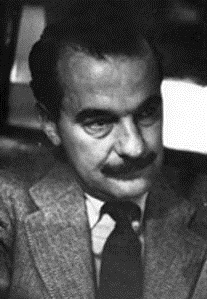<Back to Index>
- Physicist Nicholas Constantine Metropolis, 1915
- Film Director Michalis Kakoyannis, 1922
- Major General of the Colonial Patriot Militia Joseph Warren, 1741
PAGE SPONSOR


Nicholas Constantine Metropolis (June 11, 1915 – October 17, 1999) was a Greek American physicist.
Metropolis received his B.Sc. (1937) and Ph.D. (1941) degrees in physics at the University of Chicago. Shortly afterwards, Robert Oppenheimer recruited him from Chicago, where he was at the time collaborating with Enrico Fermi and Edward Teller on the first nuclear reactors, to the Los Alamos National Laboratory. He arrived in Los Alamos, on April 1943, as a member of the original staff of fifty scientists.
After the World War II he returned to the faculty of the University of Chicago as an Assistant Professor. He came back to Los Alamos in 1948 to lead the group in the Theoretical (T) Division that designed and built the MANIAC I computer in 1952 and MANIAC II in 1957. (He chose the name MANIAC in the hope of stopping the rash of such acronyms for machine names, but may have, instead, only further stimulated such use.) From 1957 to 1965 he was Professor of Physics at the University of Chicago and was the founding Director of its Institute for Computer Research. In 1965 he returned to Los Alamos where he was made a Laboratory Senior Fellow in 1980.
In the 1950s, a group of researchers led by Metropolis developed the Monte Carlo method. Generally speaking, the Monte Carlo method is a statistical approach to solve deterministic many - body problems. In 1953 Metropolis co-authored the first paper on a technique that was central to the method now known as simulated annealing. This landmark paper showed the first numerical simulations of a liquid. Although credit for this innovation has historically been given to Metropolis, the entire theoretical development in fact came from Marshall Rosenbluth, who later went on to distinguish himself as the most dominant figure in plasma physics during the latter half of the 20th century. The algorithm for generating samples from the Boltzmann distribution was later generalized by W.K. Hastings to become the Metropolis - Hastings algorithm. He is credited as part of the team that came up with the name Monte Carlo method in reference to a colleague's relative's love for the Casinos of Monte Carlo. Monte Carlo methods are a class of computational algorithms that rely on repeated random sampling to compute their results. In statistical mechanics applications prior to the introduction of the Metropolis algorithm, the method consisted of generating a large number of random configurations of the system, computing the properties of interest (such as energy or density) for each configuration, and then producing a weighted average where the weight of each configuration is its Boltzmann factor, e − E / kT, where E is the energy, T is the temperature, and k is the Boltzmann constant. The key contribution of the Metropolis paper was the idea that
Instead of choosing configurations randomly, then weighting them with exp(−E/kT), we choose configurations with a probability exp(−E/kT) and weight them evenly.
Metropolis was a member of the American Academy of Arts and Sciences, the Society for Industrial and Applied Mathematics and the American Mathematical Society. In 1987 he became the first Los Alamos employee honored with the title "emeritus" by the University of California. Metropolis was also awarded the Pioneer Medal by the Institute of Electrical and Electronics Engineers, and was a fellow of the American Physical Society.
The Nicholas Metropolis Award for Outstanding Doctoral Thesis Work in Computational Physics is awarded annually by the American Physical Society.
Metropolis played the part of a scientist in the
Woody Allen film Husbands and Wives (1992).
In his memoirs, Stanislaw Ulam remembers that a small group, including himself, Metropolis, Calkin, Konopinsky, Kistiakowsky, Teller and von Neumann, spent several evenings at Los Alamos playing poker. They played for very small sums, but: "Metropolis once described what a triumph it was to win ten dollars from John von Neumann, author of a famous treatise on game theory. He then bought his book for five dollars and pasted the other five inside the cover as a symbol of his victory." In another passage of his book, Ulam describes Metropolis as "a Greek - American with a wonderful personality."